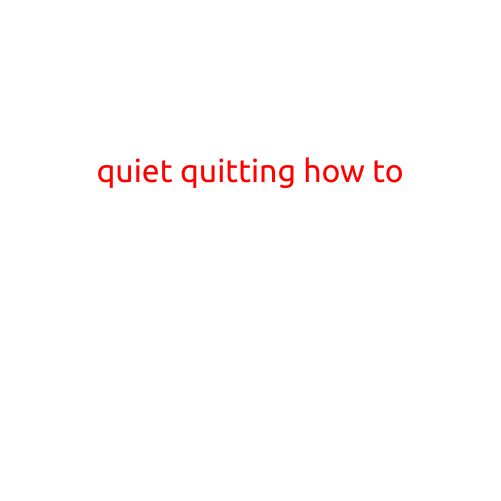
Quiet Quitting: The Secret to Achieving Work-Life Balance
In today’s fast-paced and competitive work environment, it’s easy to get caught up in the hustle and bustle of constantly pushing yourself to achieve more. However, quiet quitting is a relatively new concept that suggests taking a step back from this overcommitting mindset and instead, focusing on maintaining a healthy work-life balance.
What is Quiet Quitting?
Quiet quitting is not about slowing down or lacking motivation, but rather, it’s about being intentional with your time and energy. It’s about setting clear boundaries, prioritizing your well-being, and avoiding burnout. This approach encourages individuals to re-evaluate their priorities, habits, and goals, with a focus on sustainability and long-term success.
Benefits of Quiet Quitting
By embracing quiet quitting, you can experience numerous benefits, including:
- Reduced stress and anxiety
- Improved work-life balance
- Increased productivity and focus
- Enhanced creativity and innovation
- Better relationships and communication with colleagues and loved ones
How to Quiet Quit
Implementing quiet quitting requires intentional effort, but with these simple steps, you can start your journey towards achieving a healthier work-life balance:
- Set Boundaries: Establish clear boundaries with your work and personal life. This includes setting specific work hours, avoiding work-related activities during free time, and prioritizing self-care activities.
- Prioritize: Focus on your core responsibilities and delegate tasks when possible. Eliminate non-essential activities and avoid taking on too much at once.
- Communicate: Openly communicate your boundaries and expectations with your employer, colleagues, and loved ones. This ensures that everyone is on the same page and respects your time and energy.
- Practice Self-Care: Schedule self-care activities, such as exercise, meditation, or hobbies, and prioritize them just as you would work-related tasks.
- Re-evaluate Goals: Assess your long-term goals and prioritize those that align with your values and priorities. Avoid overcommitting to goals that may not be realistic or sustainable.
- Disconnect: Regularly disconnect from work-related activities and electronic devices outside of work hours. This allows you to recharge and maintain a healthy work-life balance.
- Monitor Progress: Regularly monitor your progress, adjust your approach as needed, and celebrate your successes.
Common Objections to Quiet Quitting
Some of the common objections to quiet quitting include:
- “I’ll be seen as lazy or un committed.”
- “I’ll miss out on opportunities and promotions.”
- “I’ll be overwhelmed with my current workload.”
However, research shows that quiet quitting can have the opposite effect. When individuals prioritize their well-being and set boundaries, they are more likely to be productive, focused, and successful in the long run.
Conclusion
Quiet quitting is a powerful approach to achieving work-life balance and maintaining long-term success. By setting boundaries, prioritizing, communicating, practicing self-care, re-evaluating goals, disconnecting, and monitoring progress, you can experience the numerous benefits of quiet quitting. Remember, quiet quitting is not about slowing down, but about being intentional with your time and energy. Start your journey today and discover a healthier, more sustainable way to work and live.





